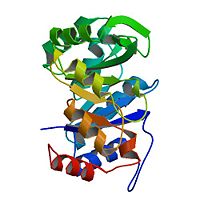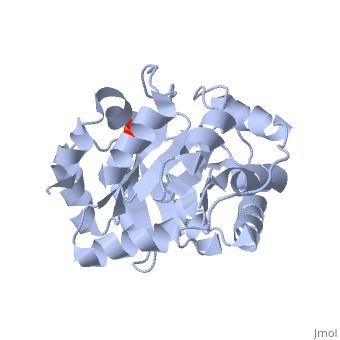
Publication Abstract from PubMed
Understanding enzyme catalysis through the analysis of natural enzymes is a daunting challenge-their active sites are complex and combine numerous interactions and catalytic forces that are finely coordinated. Study of more rudimentary (wo)man-made enzymes provides a unique opportunity for better understanding of enzymatic catalysis. KE07, a computationally designed Kemp eliminase that employs a glutamate side chain as the catalytic base for the critical proton abstraction step and an apolar binding site to guide substrate binding, was optimized by seven rounds of random mutagenesis and selection, resulting in a >200-fold increase in catalytic efficiency. Here, we describe the directed evolution process in detail and the biophysical and crystallographic studies of the designed KE07 and its evolved variants. The optimization of KE07's activity to give a k(cat)/K(M) value of approximately 2600 s(-1) M(-1) and an approximately 10(6)-fold rate acceleration (k(cat)/k(uncat)) involved the incorporation of up to eight mutations. These mutations led to a marked decrease in the overall thermodynamic stability of the evolved KE07s and in the configurational stability of their active sites. We identified two primary contributions of the mutations to KE07's improved activity: (i) the introduction of new salt bridges to correct a mistake in the original design that placed a lysine for leaving-group protonation without consideration of its "quenching" interactions with the catalytic glutamate, and (ii) the tuning of the environment, the pK(a) of the catalytic base, and its interactions with the substrate through the evolution of a network of hydrogen bonds consisting of several charged residues surrounding the active site.
Evolutionary optimization of computationally designed enzymes: Kemp eliminases of the KE07 series., Khersonsky O, Rothlisberger D, Dym O, Albeck S, Jackson CJ, Baker D, Tawfik DS, J Mol Biol. 2010 Mar 5;396(4):1025-42. Epub 2009 Dec 28. PMID:20036254
From MEDLINE®/PubMed®, a database of the U.S. National Library of Medicine.
A series of computationally designed enzymes that catalyze the Kemp elimination have described. Kemp eliminase (KE07) has . The Kemp elimination of was chosen as a model reaction for proton (H) transfer from carbon, simultaneously with the cut of the nitrogen–oxygen (N-O) bond, resulting in . Such reaction is a critical step in many enzymatic reactions. The catalytic base (E101), the general acid/H-bond donor (K222), and the stacking residue (W50) make interactions with the 5-nitrobenzisoxazole at the . Directed evolution can significantly improve the stability, expression and activity of enzymes. In the catalytically improved directed evolutionary variants of KE07 containing the , Asp7 breaks the Glu101–Lys222 salt bridge (for example 3iiv, chain A is shown).
The comparison of the (colored orange) modelled in the presence of the 5-nitrobenzisoxazole and (2rkx, (colored lime) of KE07 shows only limited conformational changes. In the , the amino group of Lys222 is ~4 Å away from the transition state phenolic oxygen, to stabilize the negative charge of the product phenoxide. However, Lys222 can also form a weak salt bridge with the catalytic Glu101 with a distance of ~3.6 Å. In the of the KE07 without ligand (2rkx), the Glu101–Lys222 distance is 2.84 Å, i.g. within salt bridge distance. This is probably a unique feature of the unbound conformation of KE07. As was mentioned above, in the catalytically improved directed evolutionary mutants of KE07 bearing the , Asp7 breaks the Glu101–Lys222 salt bridge (in the evolved mutants, the NεLys222–OγGlu101 distance is 3.3–5.7 Å), in some cases directly (as in the present case 3iiv, chain A) interacting with Lys222 (the NεLys222–OβAsp7 distance is 2.8–5.7 Å). of the structures of the wildtype (lime) KE07) and the its evolved Ile7Asp mutant reveals how the Ile7Asp mutation causes the shift of the Lys222 side chain away from Glu101.
The residues Arg5, Glu46, Lys99, and Glu167 of KE07 unbound wildtype crystal structure (2rkx) form at the bottom of the active site. In this case Lys222, of course, is not involved in this network, because it could not form electrostatic interaction with Ile7. Ile7Asp mutation in the evolved mutants introduces Lys222 to this electrostatic network or as in case of 3iiv, chain A, or (3iiv, chain B.
The crystal structures of the catalytically improved directed evolutionary KE07 mutants also demonstrate that replacement of side chains via mutations, combined with minor backbone changes, could allowed the new enzyme–substrate interactions. For example, of the structures of the KE07 design and evolved KE07 round 4 1E/11H chain A (3iio) reveals that the mutation Gly202Arg caused a shift of the adjacent loop (residues 175–177) and could introduce a new interaction with the nitro group of the 5-nitrobenzisoxazole. The directed evolution also creates new interaction networks of charged surface residues at the upper part of the active site. In the (2rkx, colored lime), Gly is in the position 202, Asn is in the position 224, and distance between Asn224 O and His201 N is 7.9 Å. In the evolved variants, following the Gly202Arg and Asn224Asp mutations, Asp224 and His201 gradually became closer, with distances between Asn224 O and His201 N of 4.6 Å in the (3iio, colored darkmagenta) and 3.6 Å in the (3iiv, colored tan). In rounds 6-7 variants, Asp224 can potentially interact with Arg202 and with His201. This network of Arg202–Asp224–His201 also brings His201 closer to the substrate (not shown). Interestingly, the at the active site in chain A of round 7 1/3H variant (3iiv) significantly differs from those in all other structures, including chain B) within the asymmetric unit of round 7 1/3H. Of note, that Trp50 of chain A overlaps the substrate. For more details see Kemp elimination catalyst.
- KE07, KE59, KE70 and KEhg3.17 are kemp eliminases with various sets of mutations, each one improving the catalytic efficiency of the reaction converting 5-nitrobenzinsoxazole to cyanophenol[1]


